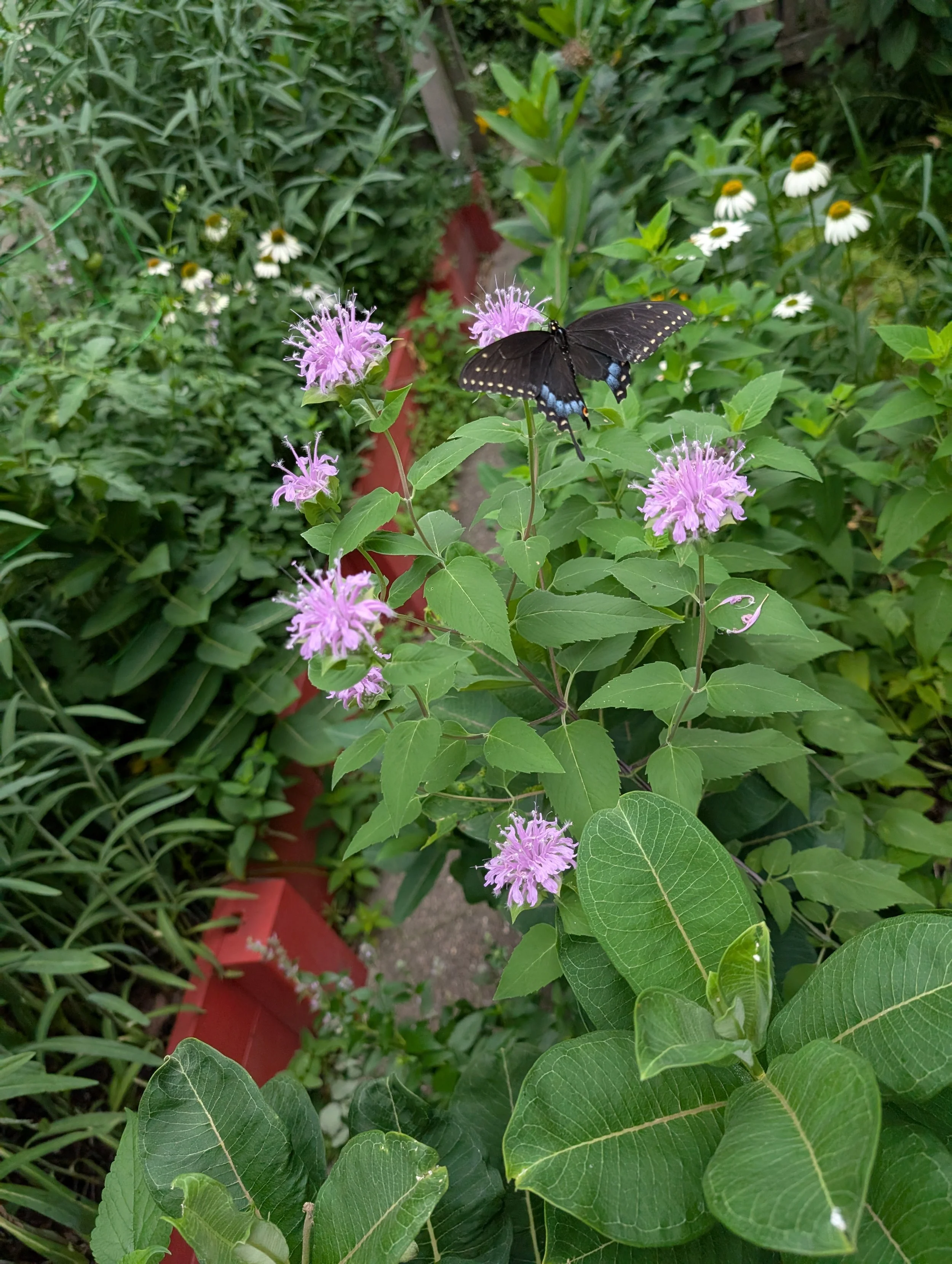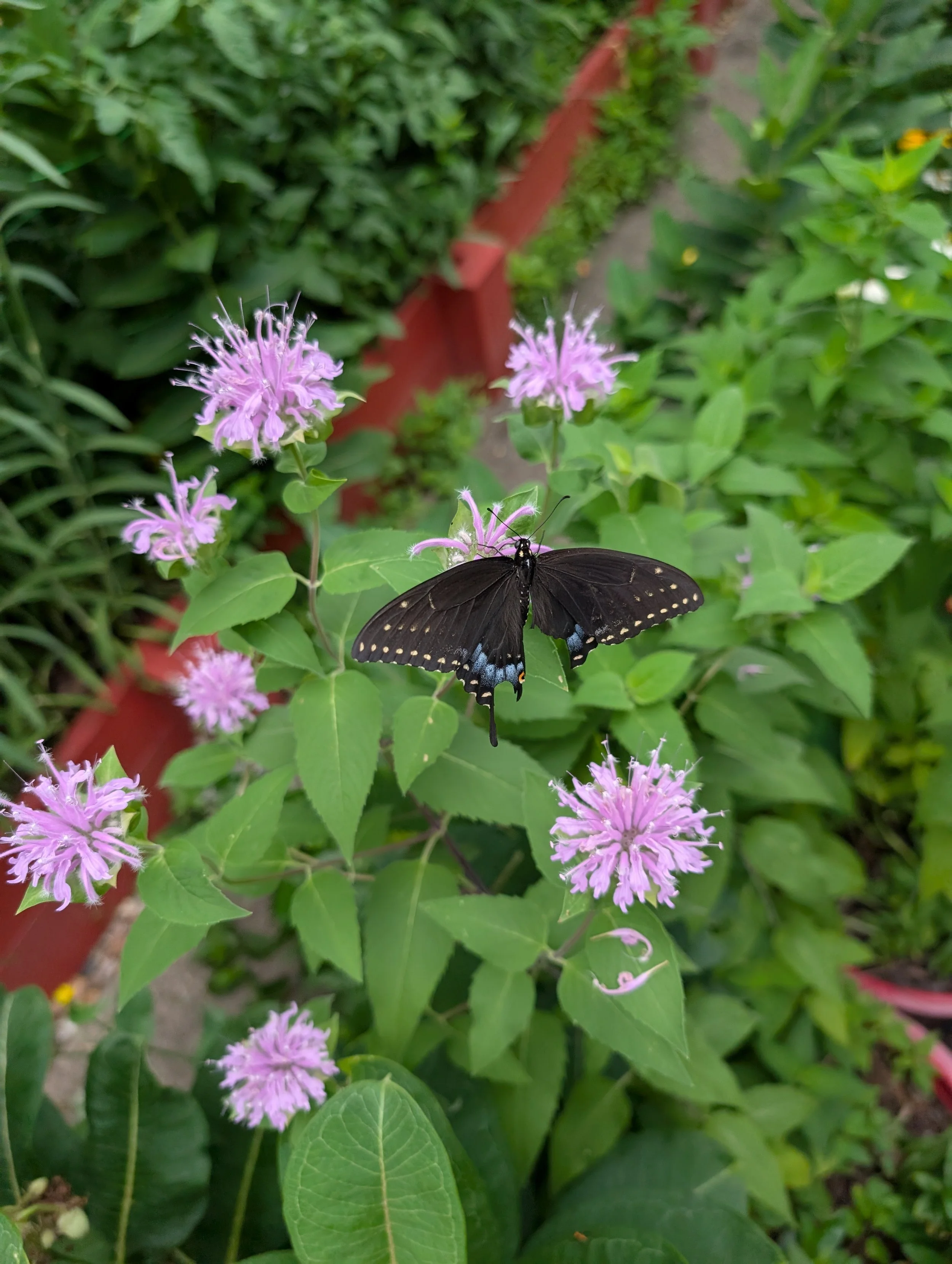Papilio polyxenes (black swallowtail )
Taxonomy & Description
Scientific name: Papilio polyxenes
Common names: Black swallowtail, American swallowtail
Family: Papilionidae
Range: Widely distributed across North America, from southern Canada through the United States and into parts of Central and South America.
Habitat: Open fields, prairies, meadows, roadsides, gardens, and edges of woodlands.
Ecological Role
Pollination
Adults are generalist nectar feeders and pollinate a wide variety of native and garden flowers.
They are especially attracted to composite flowers (Asteraceae), milkweeds (Asclepias spp.), and mints (Lamiaceae).
Food Web Contribution
Larvae: Serve as prey for birds, spiders, wasps, and tachinid flies.
Adults: Provide food for insectivorous birds and other predators.
Their presence indicates healthy populations of native umbelliferous (Apiaceae) plants.
















Lifecycle
Egg Stage (3–9 days)
Eggs are laid singly on host plant leaves.
Initially pale yellow, darken before hatching.
Larval Stage (Caterpillar)
Instars: 5 stages; early instars resemble bird droppings (brown/white) for camouflage; later instars are bright green with black bands and yellow spots.
Duration: ~10–30 days depending on temperature.
Defense: Osmeterium (orange, forked gland) emits foul odor to deter predators.
Pupal Stage (Chrysalis)
Pupates on stems or nearby vegetation.
Two color morphs: green or brown (camouflage to environment).
Overwintering occurs in this stage in northern climates.
Adult Stage
Wingspan: 3–4.5 inches.
Flight period: Spring to fall; multiple broods in warmer regions.
Adults live 2–3 weeks, seeking nectar and mates.
Native Host Plants
Black swallowtail caterpillars specialize on plants in the Apiaceae (carrot/parsley family) and occasionally Rutaceae (citrus family). Native hosts are essential for supporting wild populations.
Key Native Host Plants (Central & Eastern North America)
Golden Alexander (Zizia aurea) – One of the most important native larval hosts.
Mock Bishop’s Weed (Ptilimnium capillaceum)
Additional Native or Naturalized Hosts
Wild carrot/Queen Anne’s lace (Daucus carota) – naturalized, not native but widely used.
Fennel, dill, parsley – common garden plants that can supplement but do not replace natives.
Nectar Plants for Adults
Planting a mix of native nectar plants ensures adults have resources throughout the season:
Milkweeds (Asclepias spp.)
Purple coneflower (Echinacea purpurea)
Bee balm (Monarda fistulosa)
Blazing stars (Liatris spp.)
Asters (Symphyotrichum spp.)
Joe-Pye weed (Eutrochium spp.)
Conservation & Garden Support
Plant multiple native host plants in clumps to help larvae find food.
Avoid pesticide use; larvae are highly susceptible to insecticides.
Provide sunny areas with shelter from wind.
Include nectar plants that bloom spring through fall for adults.
Overwintering pupae can be left undisturbed in garden debris or stems.
Ecological Significance
Acts as a keystone pollinator in mixed meadow and prairie ecosystems.
Supports predator and parasitoid diversity.
Its reliance on native Apiaceae plants makes it an indicator species for the health of prairie and open meadow habitats.
1. Planting Plan (Chicago Region, Native-Focused)
Goals
Provide host plants (larval food) and nectar plants (adult food) throughout the growing season.
Mimic natural prairie/meadow edges to support black swallowtails and other pollinators.
Use native species from Chicago’s ecoregion (Central Tallgrass Prairie) for ecological integrity.
A. Host Plants (Larval Food)
Black swallowtail caterpillars rely primarily on native members of the Apiaceae (carrot family):
Core Larval Hosts (must-haves)
Golden Alexander (Zizia aurea)
Blooms: May–June
Early-season host; cornerstone for native gardens.
Heart-leaved Alexander (Zizia aptera)
Blooms: May–June
Thrives in part shade; complements Z. aurea.
Meadow Parsnip (Thaspium trifoliatum)
Blooms: May–June
Adds diversity; prefers open woodland edges.
Cow Parsnip (Heracleum maximum)
Blooms: June–July
Large plant; great for wetter spots.
Optional Native Hosts
Angelica (Angelica atropurpurea)
Water Parsnip (Sium suave)
B. Nectar Plants (Adult Food)
Choose plants with overlapping bloom times (spring–fall):
Spring (March–May)
Wild columbine (Aquilegia canadensis)
Golden Alexanders (Zizia aurea) – doubles as host & nectar
Wild geranium (Geranium maculatum)
Summer (June–August)
Bee balm (Monarda fistulosa)
Purple coneflower (Echinacea purpurea)
Blazing stars (Liatris spicata, L. aspera)
Milkweeds (Asclepias tuberosa, A. syriaca)
Fall (August–October)
New England aster (Symphyotrichum novae-angliae)
Smooth blue aster (Symphyotrichum laeve)
Goldenrods (Solidago speciosa, S. rigida)
C. Planting Design Tips
Sunny location: 6+ hours sunlight daily.
Group in clumps: 3–5 of each species to make finding plants easier for butterflies.
Layer heights: Tall nectar plants (asters, joe-pye) at back; medium (coneflowers, bee balm) mid; low (golden alexander) front.
Watering: Most natives tolerate drought once established; cow parsnip & water parsnip need moist soils.
Avoid pesticides: Even “organic” sprays harm larvae.
Example 10' x 10' Butterfly Patch
Host layer (center & edges): 3 Zizia aurea, 2 Thaspium trifoliatum
Nectar spring: 3 Aquilegia canadensis
Nectar summer: 4 Monarda fistulosa, 3 Echinacea purpurea, 2 Liatris spicata
Nectar fall: 3 Symphyotrichum novae-angliae, 3 Solidago speciosa
2. Life Cycle & Flight Period (Illinois / Great Lakes)
Black swallowtails are multi-brooded in the Midwest, with timing influenced by temperature.
Spring (April–June)
Overwintered chrysalides emerge in April/May.
Adults seek early nectar (columbine, golden alexander).
Egg laying begins mid-May on early host plants (Zizia spp.).
Summer (June–August)
2nd and 3rd generations common.
Eggs hatch within 3–9 days; caterpillars feed for ~2–4 weeks.
Pupae form on nearby vegetation; some emerge in ~2 weeks (summer brood), others overwinter (late brood).
Fall (September–October)
Last adults seen late September into early October.
Late-season caterpillars pupate and overwinter as chrysalides.
Overwintering (November–March)
Chrysalides remain dormant, often camouflaged on stems or garden debris.
Leaving standing stalks and leaf litter through winter is critical for survival.
Chicago Flight Period Summary
First Adults: Mid-April
Peak Activity: June–August
Last Adults: Early October
Broods per year: 2–3
Extra Conservation Tips
Plant continuous blooms March–October.
Include moisture sources (shallow dish with pebbles for puddling).
Leave seed heads and stems standing until spring cleanup.
Intermix host and nectar plants for easy access.
Combine with other butterfly hosts (milkweeds for monarchs, violets for fritillaries) for broader habitat value.
